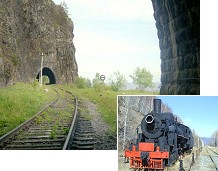| Origin & Development | |
|
Legends & Fairy tales • Earth's Crust Thickness • Underwater Relief • Landscapes • History & Formation • Seismic Activity • | |
| History of Lake Baikal | |
|
History of Explorations • Inhabitants & Settlers • First maps of Baikal • Archaeological Sites • | |
| Lake Baikal Climate | |
|
Introduction • Fogs • Winds & Waves • Ice Conditions • | |
| Fauna & Vegetation | |
|
Mammals • Baikal seal - Nerpa • Ichthyofauna • Invertebrates • Vegetation • | |
| Water of Lake Baikal | |
|
Colour • Transparency • Temperature • Pressure • Depth • Currents • Budget • Chemical Composition • Pollution • | |
| Recreational Areas | |
|
Circumbaikal Railway • Peschanaya Bays • Olkhon Island • Chivirkuysky Gulf • Wooden Irkutsk • Trans-Siberian Railway • | |
| People of Lake Baikal | |
|
People of Siberia • Buryat nation in Baikal • Russians in Baikal • | |
|
| |
Round Baikal Railway / Circumbaikal Railway
Formerly it was the most exotic part of the Trans-Siberian Railway. The sacred lake with all its awesome beauty passed before the eyes of the passengers of the trains going eastwards. On the one side, the rocks pile up unimaginably high. The lake shining and sparkling is bound on the other side by dove-coloured mountains. The waves from the lake "lick" the car-wheels. The construction of the Circumbaikal Railway as part of Trans-Siberian Railway (the section from Port Baikal on the south-western shore of the lake) to Mysovaya Station (on the south-eastern shore) took 4 years. Ancient crystal rocks: granite, gneiss, gabbro, diabase, - possess enormous strength; the steep rocky shores precipitously go under water, forcing to make excavations and niches in rocky cliffs, to construct arches and tunnels. The quiet grandeur of the plain stone portal with its high quality masonry and the way the arch joins the coastal slope, charms the visitor. It seems to have been there for ages rather than only three quarters of a century. The railway is 84 km long. It includes not only russian engineering design of that time but also of the hard work of Russian, Polish, Italian and English workers. The Circumbaikal Railway needed 200 bridges and 33 tunnels. Only within the section of 56 miles from Kultuk to Port Baikal there are 48 arches and tunnels. Most of the tunnels are not very long. There are a few tunnels long enough so that passengers experience total darkness. Polovynny Cape is cut through by the longest one (800m). And how many bridges, supporting the walls! It is no coincidence that this part is righteously regarded as the museum of Russian engineering thought, and foreign tourists respectfully name it - "The Golden Buckle of the Great Siberian Trail". |
